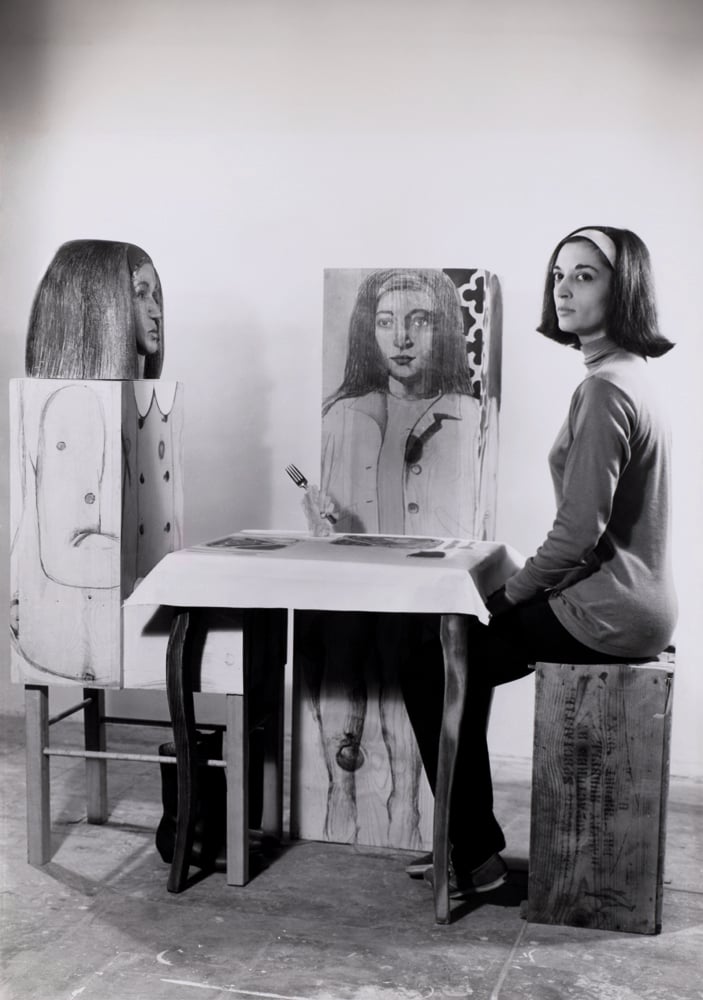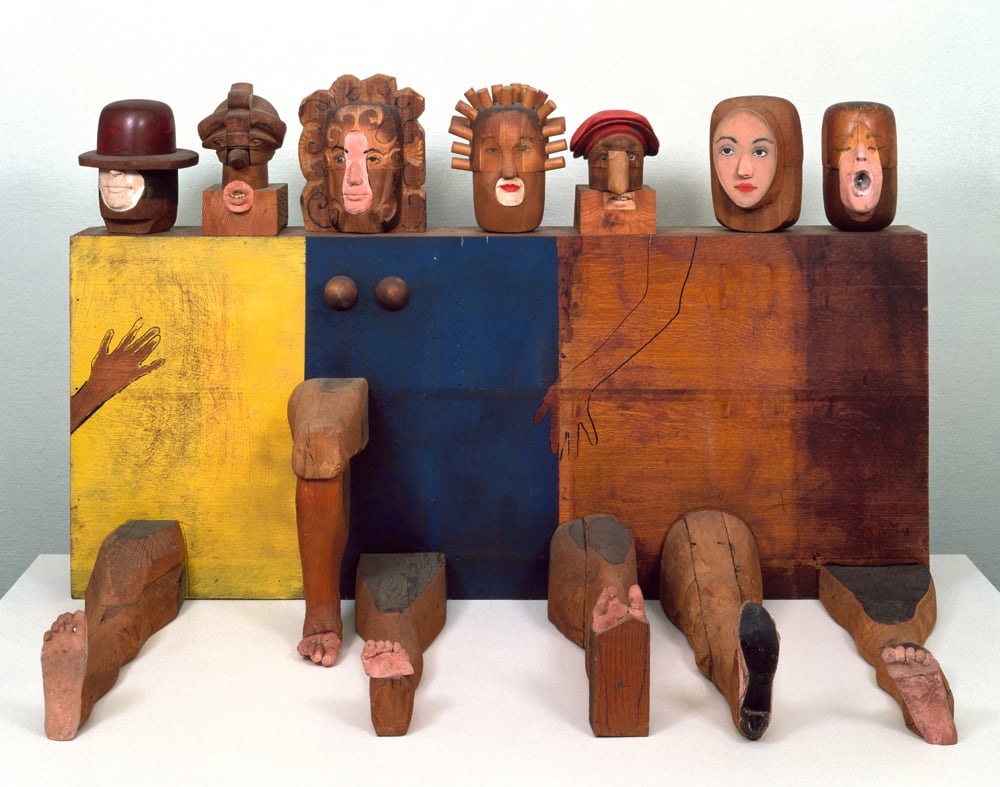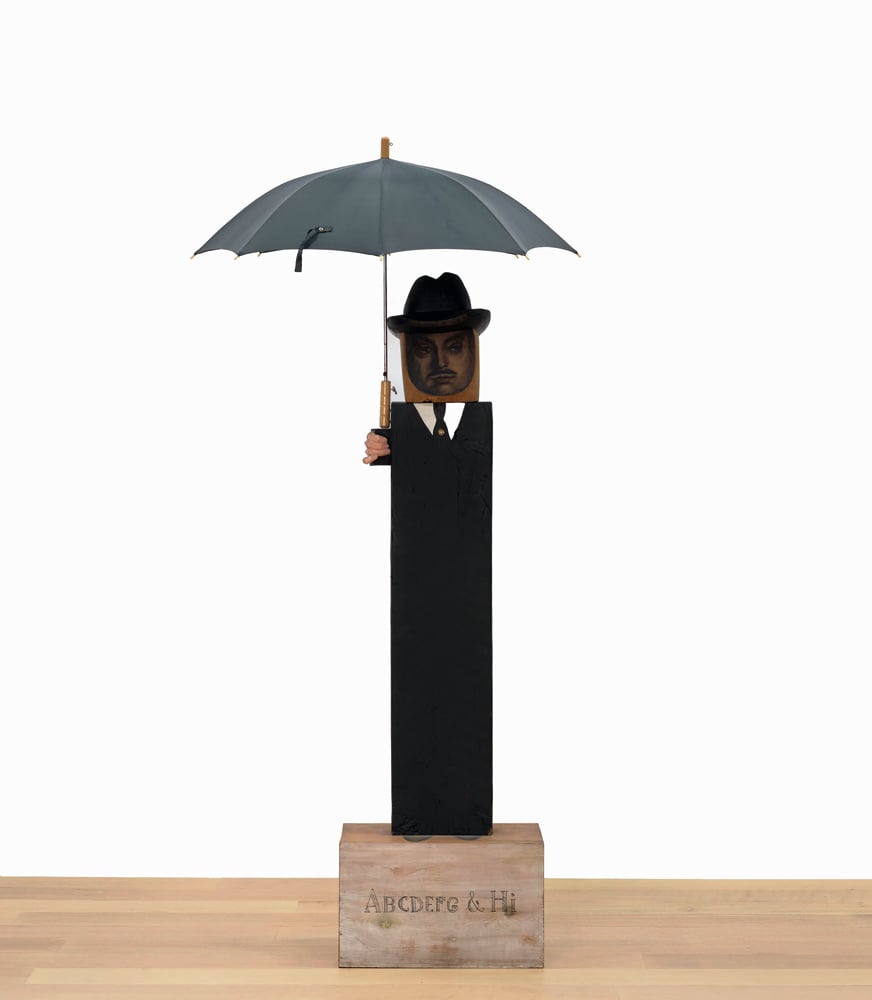An enormously influential figure on the 1960s art scene, Marisol crossed paths with Andy Warhol, and suddenly found herself labelled a Pop artist – which may have done her more harm than good. While she shares Pop’s mockery of societal expectations, her work goes much further, marked as it is by her deep distrust of appearances and her horror of social conventions. As the Fondation Louis Vuitton dedicates a retrospective to her until February 25, 2024, Numéro takes a look back at the career and work of one of the greatest fashion icons of the 60s.


© Estate of Marisol / Buffalo AKG Art Museum / Artists Rights Society (ARS), New York.
Marisol, the first glamorous female artist
In the 60s, she was a fashion icon, an it-girl accustomed to magazine covers, whom Andy Warhol (whose portrait she portrayed in sculpture) in two of his films and defined as “the first glamorous female artist”. His popularity went far beyond the boundaries of the art world; However, in the 70s, it fell into relative oblivion from which it did not really emerge when it disappeared in 2016. “In the 60s, she had more press and visibility than Andy Warhol,” William Grimes wrote in the obituary dedicated to her by the New York Times at the time of her death. And recalls that, when asked in 1964 how she would like the public in general, and art critics in particular, to remember her and her work, she replied: “I don’t care what they think.”
One of his sculptures from 1963 – the representation of John Wayne on a galloping red horse – will soon be on display in Paris, in the exhibition Pop Forever, Tom Wesselmann & Pop Forever. at the Fondation Louis Vuitton (from 16 October). This work was created at the request of Life magazine in 1962. It appeared on the cover of an issue devoted to John Wayne.
She was born María Sol Escobar, in Paris, in 1930, to globe-trotting Venezuelan parents. After her mother’s suicide, when she was barely 11 years old, she locked herself into a silence from which she did not emerge until she was 20 years old. “I had decided never to speak again. And I didn’t say a word for years, except in cases of absolute necessity, at school or in the street. I had gotten so used to being silent that I really didn’t have anything left to say to anyone. “
After growing up between Paris and Caracas, she attended the École Nationale Supérieure des Beaux-Arts in Paris for a year in 1949, from which she soon escaped to join the Art Students League in New York. There, she was influenced by the teaching of the Japanese painter and engraver Yasuo Kuniyoshi, whose work combines realism and the imaginary world. In the wake of the avant-garde of the time, María devoted herself to Abstract Expressionism. At the Cedar Tavern she met all the young painters who had made it their headquarters, and became friends with Willem De Kooning.
She found, however, all these people a little sinister… A visit to an exhibition of pre-Columbian art in Mexico City upset his convictions. She abandoned abstract expressionist painting to devote herself to figurative sculpture. “It started with a kind of rebellion. Everything was so serious. I was very unhappy, and the people I met were very depressing. I started doing things that I had fun to try to be happier – and it worked “, she explained in 1965 to the New York Times.


Singular combinations at the heart of Marisol’s works
His three-dimensional portraits combined Picasso’s use of eclectic materials with Rauschenberg’s assemblages. She added autobiographical elements, often using her own image. This practice gave it a singular place in the pop art with which it was later associated – even if this comparison was itself contested.
Leo Castelli, who had just opened his New York gallery, included him in a group exhibition in 1957 with Jasper Johns and Robert Rauschenberg, and then granted him a solo exhibition at the end of the same year. The radical freedom of her artistic approach then emerged, which she commented in these terms: ” I like to rely on combinations that seem incongruous – wood with plaster, drawing with a marker on wood – but in the end I put things in their natural place: a hand in the extension of the arm, a nose in the middle of the face, a hat on a head, a shoe on a foot, a foot at the end of a leg, a chest on a woman’s bust, a mouth slightly below a nose and a nostril inside that nose.”
This exhibition opened the doors to an almost certain success for the artist – who then chose to call herself Marisol Escobar, then simply Marisol. But she freed herself from it, and preferred to escape to Rome for two years. When she returned to New York, and after Life magazine had included her in its list of the 100 most important young Americans of 1962, her solo exhibitions at the Stable Gallery and the Sidney Janis Gallery made her a star – the opening at Janis’ house is remembered as the one that drew the most spectacular crowd to the gallery, Nearly 3,000 people patiently queued on the sidewalk to take part in the event.
This craze followed her throughout the 60s. In 1968, she exhibited at the Venice Biennale (where she represented Venezuela in the international competition) and was one of five women among the 150 artists invited to Documenta 4 in Kassel.


A creative spirit that frees itself from social rites
His work The Party (1968) is composed of fifteen anthropomorphic wooden totems, all in his likeness – some photographic, others in carved wood, others in plaster or resin. About him, she confided that she had used her own image because she wanted to comment satirically on social rites, but not to name anyone in particular. Although supposed to take part in a “party”, none of the characters communicates with the others, and each wears a dress that sums up his social background (the most chic dresses, which seem couture, are cheap replicas).
In social rites, precisely, she has never devoted any particular interest: “I never wanted to be a member of society. I’ve always abhorred standard behavior and conventional patterns. All my life, I have tried to distinguish myself, to look like no one. I feel very uncomfortable with codes of conduct. “Again, she set sail and set off for two years to circumnavigate the world.
“I felt the need to do something very pure, only for the beauty of the gesture… I wanted to produce something beautiful.”
Marisol
In Asia, she devoted herself to meditation, practiced scuba diving, and learned to photograph the seabed. “When I came back, I felt the need to do something very pure, just for the beauty of the gesture… I wanted to produce something beautiful .” Above all, on her return, she found an artistic scene that had changed and had moved away from her centres of interest, taking only a moderate interest in Marisol’s work. In retrospect, it is permissible to wonder about this turnaround: did Marisol not pay the price of a movement dominated by men (pop art) in which she was almost the only woman?
As early as the 1960s, several critics questioned his membership of this movement, in particular because of the autobiographical dimension of his sculptures and their satirical nature. Above all, she paid a high price for her singularity. Because one can be a contemporary of a movement (pop art), have common interests with it, but go beyond its borders. However, Marisol seems to have had a visceral distrust of borders and dogmas, and an immoderate passion for the controversy that arises from the meeting of opposites.
A photograph of her taken by Robert Mapplethorpe in 1979 shows her dressed in a hoodie and old jeans, and, at the same time, wearing a hat with a veil… This originality, which marginalized her in the 60s and 70s, is a strong asset in the posthumous re-evaluation of her work. In recent years, her work has resurfaced in numerous exhibitions, and a retrospective – the most exhaustive ever devoted to this artist – was presented in 2024 at the Montreal Museum of Fine Arts and the Buffalo AKG Art Museum in New York. At the end of her life, she said: “All my life I have learned to be patient, to whisper and not to shout, to look beyond the frame, to let myself go with the sea, to breathe the wind and to be proud to be an artist.”
“Pop Forever, Tom Wesselmann &…”, from October 17, 2024 to February 24, 2025 at the Fondation Louis Vuitton, Paris 16th.






